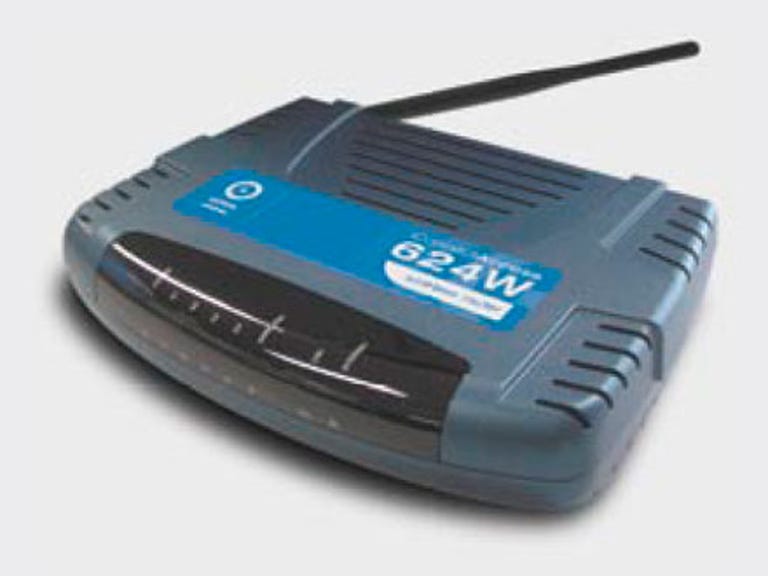 Why You Can Trust CNET
Why You Can Trust CNET iConnect Access 624W review: iConnect Access 624W
The iConnect Access 624W Wireless Router offers a very simple way to automatically configure your wireless network and home ADSL connection. Read our Australian review.
Design
In physical design terms, the iConnect Access 624W looks like a router. Pretty much any router, in fact. If you pushed us, we'd probably fall over, and after we'd gotten back up, we'd probably grumble a bit and then say that it fairly closely resembles the recently-reviewed TRENDnet TEW-432BRP, albeit in a much darker, less Smurf-friendly blue casing.
The Good
The Bad
The Bottom Line
The rear of the router houses four 10/100 Ethernet ports, a power switch and an ADSL phone line port. Inside the iConnect Access 624W's box you'll also find a power adaptor, a length of Ethernet cable, line filter and a length of phone cable, along with installation CDs and a small printed quick start guide. As is the norm with most routers, the manual is supplied in PDF format on the CD.
Features
The iConnect Access 624W Wireless Router is a 802.11g wireless router, four port 10/100 wired router and ADSL/ADSL2/ADSL2+ compatible modem.
It supports ATM QoS UBR/CBR/VBR and comes with an inbuilt SPI Firewall, and can act as either a router or wireless bridge via the inbuilt web-based interface.
Performance
This far into the review, and you're probably thinking that there's nothing that remarkable about the iConnect Access 624W. To a certain extent you'd be right; its feature set is nothing to get so terribly excited about in such a competitive market, and as a single antennae, 802.11g router you probably couldn't expect too much from it in terms of signal strength. That was the case in our testing, where the 624W performed acceptably well, but in no way exceptionally.
So what makes the iConnect Access 624W stand out? It's the installation software, which is tailored to each specific ISP that you purchase it from. This takes the form of a Flash-based interactive setup routine that takes a very simple, handheld approach to setting up the router and the surrounding wireless network. If you're a networking novice this kind of thing is a godsend, as the 624W will take care of setting your environmental variables -- passwords and so on -- and all you really need are details that your ISP should provide you with anyway, such as username and password.
In our tests we were, for the most part impressed with how easy the 624W made installing and setting up a wireless network. We did however have a few reservations. One of our test laptops was a Centrino model running the Intel ProSET Wireless utility, and the 624W didn't like it all that much. Its configuration utility presumes that you're always just using the Windows wireless configuration utility, and conflicts with other driver-based configuration utilities. The explanation of how to disable ProSET and use the Windows utility was rather short in our opinion, and in stark contrast to the handholding that the 624W offers otherwise.
There were other small niggles that we encountered in the installation, although they were slightly more minor. Installation includes entering your password, but in direct contrast to just about every password setup routine ever, your password is on display as you enter it, reducing its effectiveness somewhat. In the home/consumer setting that the 624W is pitched to this is admittedly less of a concern, but it's still poor security. In the same area of installation mistakes that could have been easily rectified, the default password for the router's web configuration page contains a zero -- but the printed text makes it difficult to work out if it's a zero or an "O". Not terribly shattering stuff, but it's also stuff that could have been fixed rather easily as well. In comparison to the very easy configuration utility, the 624W's web interface feels a little cluttered, although for the target market of this particular router, you're probably not expected to spend too much time tinkering with the small details.
During our set-up testing, the install routine intelligently spotted our network resources, and even advised of a potential conflict with an existing router -- very intelligent stuff. We were somewhat concerned that, despite running an existing WPA-secured network on the same hardware, the 624W elected to set up a less secure WEP network instead. Again, at a home level this is probably less of a concern than at a business level, but it's important to realise that this kind of easy set-up may not give you the best possible security level.



